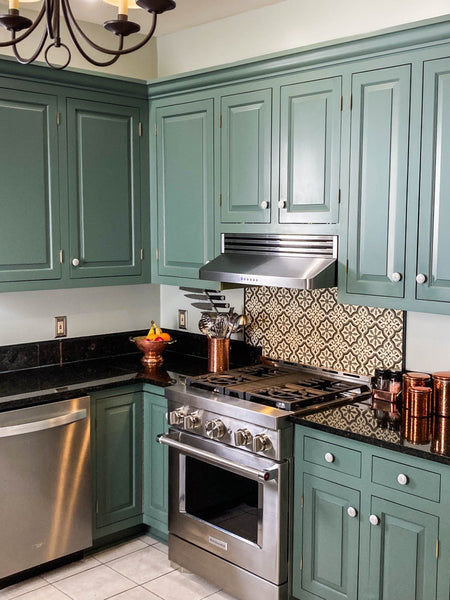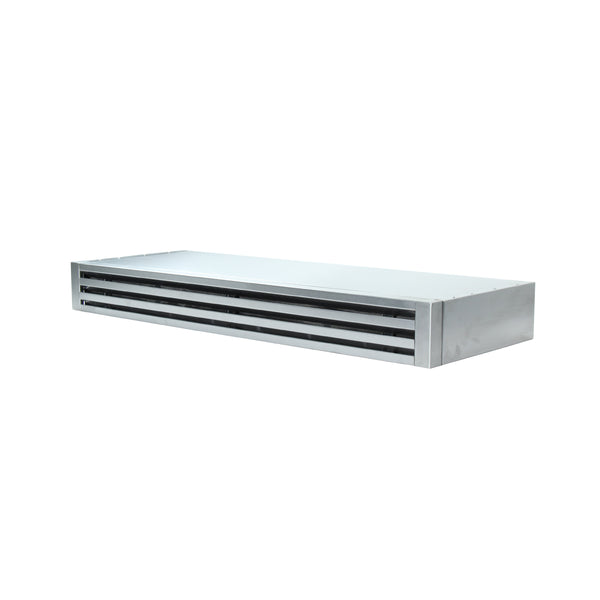No, you should never vent your range hood into the attic. The excess buildup of grease and moisture in your attic will ruin it and over time may cause mold damage. Instead, vent your hood through an interior wall or through the ceiling all the way outside of your home.
Here are four reasons to avoid venting your hood into the attic.
4 Reasons to Avoid Venting Your Hood Into the Attic

Your greasy kitchen air never leaves the home, which leads to poor indoor air quality.
Although your kitchen air may appear clean, you’ve simply moved the dirty air a few feet upward, out of sight in your attic. All the grease, dirt, and unwanted contaminants from your kitchen air sit in your attic and you breathe it in.
Just because the air is in your attic doesn’t mean you're safe from its harmful effects. In fact, the air in your attic escapes into your home and fills the house.
So, by venting your hood into the attic, you haven’t actually solved the problem of evacuating the grease and smoke from your home.
Your attic will be covered with grease and moisture which may result in mold and damage.
You’ll not only breathe in the greasy air and smoke, but it’ll cause damage to your attic over time.
Let’s say you boil a pot of water for spaghetti. That steam moves through your duct and accumulates in your attic. Then, the next day you cook Asian food at high heat and heavy smoke moves into your attic as well.
That steam and smoke aren’t going anywhere. In fact, they’ll just sit in your attic and get all over the walls and ceiling. Eventually, the insulation in your attic will wear down. Especially as moisture builds up, wood supports will start to decay and mold may accumulate.
Food particles produced from cooking could attract insects and other pests, too.
This is a homeowner’s worst nightmare, so be sure to duct your hood to the outside!
It will take work to keep your attic well-maintained.
Let’s say you bought a new home with a hood that’s vented into the attic. There’s no need to panic, but you need to make sure to duct it to the outside as soon as possible. Make that number one on your priority list and you’ll be just fine.
The longer you have the hood venting into the attic, the more difficult it will get to keep the attic clean. In the long run, it won’t be good for your health, either – especially if you have breathing problems such as asthma or COPD.
Condensation may build up in your attic.
Condensation may build up in your attic if 1) it’s cold or 2) your attic is significantly colder than your kitchen.
When the warm air from your cooking comes into contact with cold ductwork, this creates condensation which can build up over time. After a few weeks, you may have a lot of water to deal with in your attic, which is not pleasant.
If you’re in a climate where it gets below freezing, the moisture may accumulate as ice and then melt all at once in spring. That’s not fun to clean up.
Also, if you have a low spot in your duct, the water may accumulate there and you’ll have a puddle of water to mop up after a while. You don’t want heavy water in your duct for a long period of time. Steel ducts may rust and air won’t be able to flow as efficiently.
Do you have to vent a range hood to the outside?
In most places, it’s not required to vent a range hood to the outside, but it’s highly recommended. But, if your only other choice is to vent your hood into the attic, definitely vent the hood to the outside instead.
You can also invest in a ductless or recirculating range hood. A ductless hood moves your kitchen air through charcoal filters and then recirculates it back into your kitchen. These hoods don’t require ductwork. Generally, they’re a little cheaper and easier to install.
If possible, always vent your hood to the outside instead of buying a ductless hood. But, if you can’t duct to the outside, a ductless hood is certainly better than having no range hood.
Range Hood Venting Options
Horizontal Venting - 2 Options

In this example, the range hood duct extends horizontally through an interior wall to the outside of the home. This is the simplest way to horizontally vent your range hood. Wall range hoods and under cabinet range hoods can be horizontally vented to the outside.

You can also run at least 18” of vertical duct before using an elbow to duct the hood horizontally through an interior wall. Make sure that you have at least 18” of vertical duct run before inserting the elbow. Otherwise, grease will build up quickly.
If possible, avoid the vertical-to-horizontal duct run and go with Option 1.
But, in some kitchens, you won’t be able to go with Option 1 and vent the entire duct horizontally. It depends on where you’ve cut the hole for your ductwork and where you have space to run the duct.
Vertical Venting - 2 Options
If you want to vent your hood through the ceiling, you have two options. Both island range hoods and wall mount range hoods can vent through the ceiling. Wall mount range hoods can also vent horizontally, but island hoods cannot.


To learn more about venting your range hood, check out this complete guide.
Ventless (Ductless)
Your third venting option is, well, no vent at all! If you want to avoid the extra work and expense of installing ductwork, a ductless range hood might be right for you. These are great for those who live in apartments or condos, but they won’t pack as much power as ducted hoods.
Best Practices for Ducting Your Range Hood
Vent your hood through an exterior wall or through the ceiling – not to your attic.
Avoid ducting to your attic in all cases. It will save you many headaches in the long run: maintenance fees, time cleaning, repairs, and the like. The grease and condensation buildup in the attic is a hassle to deal with. For the best indoor air quality, vent your hood to the outside of your home.
Duct Size

Follow the chart above to size your ductwork appropriately. It’s most important that you don’t go smaller than these minimum duct sizes. Otherwise, your hood won’t run as efficiently as it can.
Learn more about range hood duct size in our range hood duct sizing guide.
Cap the ductwork with a wall cap or roof cap.
It’s best practice to cap your ductwork either with a wall cap or a roof cap. If you vented your hood out an exterior wall, use a wall cap. If you vented your hood out through your roof, use a roof cap.
These caps keep small debris, dirt, snow, and rain from entering your ductwork and home. They also prevent backdrafting, which occurs when the air inside your ductwork is pushed back into your kitchen.
If you’re looking for a reliable roof cap for your range hood vent, check out this list.
Find the shortest path to run your duct, with the fewest elbows.
Before you install your duct, find the shortest path outside your home that uses the fewest elbows. This will ensure that all the greasy kitchen air makes it to the outside of your home.
Elbows increase the resistance inside your duct, so we don’t recommend having more than two. Ideally, run your duct with no elbows.
Insulate your ductwork if possible.
If possible, insulate your ductwork to reduce condensation and keep air from escaping into your joists and attic. This isn’t essential, but it will slightly improve the efficiency of your hood – and keep your ductwork in great condition.
To learn more about insulating your range hood duct, check out our article ‘Should a vent hood duct be insulated?’
Thanks for stopping by our blog to learn about venting your range hood properly. To learn more about range hoods, check out some helpful articles below.
Related Articles
Can I install my hood over an open fire?
Do recirculating hoods actually work?











